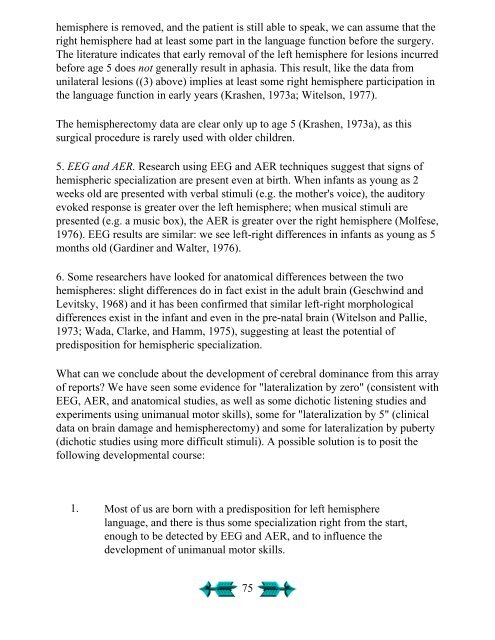Second Language Acquisition and Second ... - Stephen Krashen
Second Language Acquisition and Second ... - Stephen Krashen
Second Language Acquisition and Second ... - Stephen Krashen
You also want an ePaper? Increase the reach of your titles
YUMPU automatically turns print PDFs into web optimized ePapers that Google loves.
hemisphere is removed, <strong>and</strong> the patient is still able to speak, we can assume that the<br />
right hemisphere had at least some part in the language function before the surgery.<br />
The literature indicates that early removal of the left hemisphere for lesions incurred<br />
before age 5 does not generally result in aphasia. This result, like the data from<br />
unilateral lesions ((3) above) implies at least some right hemisphere participation in<br />
the language function in early years (<strong>Krashen</strong>, 1973a; Witelson, 1977).<br />
The hemispherectomy data are clear only up to age 5 (<strong>Krashen</strong>, 1973a), as this<br />
surgical procedure is rarely used with older children.<br />
5. EEG <strong>and</strong> AER. Research using EEG <strong>and</strong> AER techniques suggest that signs of<br />
hemispheric specialization are present even at birth. When infants as young as 2<br />
weeks old are presented with verbal stimuli (e.g. the mother's voice), the auditory<br />
evoked response is greater over the left hemisphere; when musical stimuli are<br />
presented (e.g. a music box), the AER is greater over the right hemisphere (Molfese,<br />
1976). EEG results are similar: we see left-right differences in infants as young as 5<br />
months old (Gardiner <strong>and</strong> Walter, 1976).<br />
6. Some researchers have looked for anatomical differences between the two<br />
hemispheres: slight differences do in fact exist in the adult brain (Geschwind <strong>and</strong><br />
Levitsky, 1968) <strong>and</strong> it has been confirmed that similar left-right morphological<br />
differences exist in the infant <strong>and</strong> even in the pre-natal brain (Witelson <strong>and</strong> Pallie,<br />
1973; Wada, Clarke, <strong>and</strong> Hamm, 1975), suggesting at least the potential of<br />
predisposition for hemispheric specialization.<br />
What can we conclude about the development of cerebral dominance from this array<br />
of reports? We have seen some evidence for "lateralization by zero" (consistent with<br />
EEG, AER, <strong>and</strong> anatomical studies, as well as some dichotic listening studies <strong>and</strong><br />
experiments using unimanual motor skills), some for "lateralization by 5" (clinical<br />
data on brain damage <strong>and</strong> hemispherectomy) <strong>and</strong> some for lateralization by puberty<br />
(dichotic studies using more difficult stimuli). A possible solution is to posit the<br />
following developmental course:<br />
1. Most of us are born with a predisposition for left hemisphere<br />
language, <strong>and</strong> there is thus some specialization right from the start,<br />
enough to be detected by EEG <strong>and</strong> AER, <strong>and</strong> to influence the<br />
development of unimanual motor skills.<br />
75











